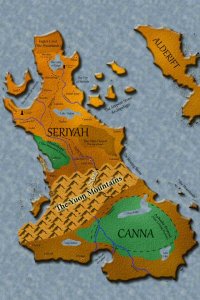 When discussing world building in science fiction and fantasy in particular, it’s important to realize that that entails more than just the setting of your story. It encompasses everything, all the details and nuances that make up the setting, culture and tools for the character to interact with. It can refer to anything from the broad—religion and politics—to the specific, such as that which directly affects the characters on a day-to-day basis.
When discussing world building in science fiction and fantasy in particular, it’s important to realize that that entails more than just the setting of your story. It encompasses everything, all the details and nuances that make up the setting, culture and tools for the character to interact with. It can refer to anything from the broad—religion and politics—to the specific, such as that which directly affects the characters on a day-to-day basis.
With that said, here are ten tips for building your fantasy/science fiction world:
- Know the rules of your world, be it how magic works to the nature and motivations of the political/religious/geographical cultures. This includes drawing a rough sketch of your world’s map, which can be helpful in maintaining consistency throughout the story.
- Know where the power is in your world. Every society is shaped by who controls it and with what tool(s) the control is acquired and maintained. Keep in mind that may or may not be physical force. Resources, religious persuasion, and other things can be just as influential in this regard.
- Don’t rely on stereotypes unless you want your world to remain vanilla and be like every other world out there. For instance, not all knights need to be so noble, not all medieval conflict needs to be so black and white.
- The happenings of your world should make sense, they should be justified. If something happens, the reader should understand why to enough degree to make it work within the rules of the world.
- Take risks. Often the best worlds are the ones that don’t follow the norm of real life. Readers read to escape, so while your world doesn’t have to be over-the-top strange, it shouldn’t bore them. Now, that doesn’t mean it can’t resemble realism…remember the character is a part of the world and his or her interaction with the world ought to always be considered in the building of your world.
- Remember that the character IS a piece of that world, not simply something that does his or her work within it, and the best characters—the best stories—are often the ones that affect the world.
- When writing your story, imagery and atmosphere should work to enhance that story, not overwhelm it (the world serves the story—the story does not serve the world). That said, as the author you ought to know more about your world than the reader ever does. This way, you can draw on that knowledge to affect your character’s decisions.
- You’re typically better off delivering the details of the world through action, rather than long-winded prose conveying the scenery. Keep in mind, ‘action’ in this case does not necessarily a fast-paced action scene. It can simply mean having the character(s) interact with the world. For instance, a better way to convey, say, “there was snow on the ground” might be, “Joe trudged through the deep snow.”
- Do your research. Study other cultures with a particular eye for how they are shaped by geography and conflict, both inner and external.
- Read and read often. Learn from the ‘greats’—specifically with an eye for how they bring the reader into their world.
Trust your instincts. Be practical and think things through, but sometimes you have to go by feel. The real world doesn’t always follow practicality, after all. What feels right for your story? If it doesn’t feel right, you’ll often end up forcing it.

I especially appreciated your number 3. There are so many “innocent nobody child born to save the world from evil” stories out there. It is nice to get lost in something where the line between good and bad is slightly blurred.
I also appreciatde point number 1. I read a lot, and the great authors obviously had a well defined A) topographical map (mountain ranges, boggy marshes, mysterious far-off islands), B) political regions map (and the social structures within) before even sitting down to begin the story arc. Without these two areas solidified, the reader cannot find firm ground in this new world.
Yeah those are key. #s 4 and 7 also strike a chord with me. Regarding 4, I hate it when authors cheat and don’t tie the strings together. Regarding 7, it drives me nuts when an author wants to tell you every nuance about the history of background items that have nothing to do with the story. Hard scifi novels sometimes fall down this crevasse.
Great piece that laid out the most important aspects of world building.
Thanks Bookwraiths!